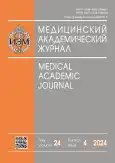Нормобарическое гипоксическое посткондиционирование корректирует формирование тревожно-депрессивного состояния в экспериментальной модели посттравматического стрессового расстройства
- Авторы: Зенько М.Ю.1, Баранова К.А.1, Рыбникова Е.А.1
-
Учреждения:
- Институт физиологии им. И.П. Павлова РАН
- Выпуск: Том 24, № 4 (2024)
- Страницы: 51-59
- Раздел: Оригинальные исследования
- URL: https://journal-vniispk.ru/MAJ/article/view/284825
- DOI: https://doi.org/10.17816/MAJ636721
- ID: 284825
Цитировать
Аннотация
Обоснование. Несмотря на стремительный рост распространенности посттравматического стрессового расстройства, до сих пор отсутствуют эффективные препараты для его терапии, поэтому разработка немедикаментозных подходов представляет собой крайне актуальную задачу, на решение которой направлено настоящее исследование.
Цель — экспериментальная оценка терапевтических эффектов гипоксического посткондиционирования с применением интервальной нормобарической гипоксии в модели подобной посттравматическому стрессовому расстройству тревожно-депрессивной патологии у крыс.
Материалы и методы. В модели посттравматического стрессового расстройства «стресс–рестресс» на крысах исследовали влияние трех режимов посткондиционирования: три 5-минутных эпизода гипоксии с 9 % кислорода, чередующихся с 15-минутными интервалами нормоксии (реоксигенации), в день в течение 3 дней после патогенного стресса (режим гипоксия/нормоксия); три эпизода по 5 мин 9 % гипоксии, чередующихся с 3-минутными интервалами гипероксии с содержанием в смеси 30 % кислорода, в день в течение 3 дней (режим гипоксия/гипероксия); пять 5-минутных эпизодов 12 % гипоксии и 3-минутной 30 % гипероксии в день в течение 9 дней (режим гипоксия/гипероксия, удлиненный). Анализировали поведение животных, функцию гипоталамо-гипофизарно-адренокортикальной системы и показатели общего анализа крови.
Результаты. Все режимы нормобарического посткондиционирования в той или иной степени оказывали корректирующее действие на проявление патологической симптоматики в модели посттравматического стрессового расстройства на крысах, однако по совокупности протективных и отсутствию побочных эффектов трехкратное посткондиционирование гипоксией/гипероксией превосходило другие режимы.
Заключение. Результаты свидетельствуют о перспективности посткондиционирования с применением интервальной нормобарической гипоксии/гипероксии для терапии тревожно-депрессивных расстройств у человека, включая посттравматическое стрессовое расстройство.
Полный текст
Открыть статью на сайте журналаОб авторах
Михаил Юрьевич Зенько
Институт физиологии им. И.П. Павлова РАН
Email: zenkomichail@mail.ru
ORCID iD: 0000-0002-9868-0598
SPIN-код: 6632-3116
научный сотрудник лаборатории регуляции функций нейронов мозга
Россия, 199034, Санкт-Петербург, наб. Макарова, д. 6Ксения Александровна Баранова
Институт физиологии им. И.П. Павлова РАН
Email: ksentippa@mail.ru
ORCID iD: 0000-0002-2746-2040
SPIN-код: 2648-7415
канд. биол. наук, старший научный сотрудник лаборатории регуляции функций нейронов мозга
Россия, 199034, Санкт-Петербург, наб. Макарова, д. 6Елена Александровна Рыбникова
Институт физиологии им. И.П. Павлова РАН
Автор, ответственный за переписку.
Email: rybnikovaea@infran.ru
ORCID iD: 0000-0002-8956-726X
SPIN-код: 9663-4704
д-р биол. наук, профессор РАН, заместитель директора по научной работе, заведующая лабораторией регуляции функций нейронов мозга, научный руководитель отдела физиологии и патологии высшей нервной деятельности
Россия, 199034, Санкт-Петербург, наб. Макарова, д. 6Список литературы
- Деев И.А., Кобякова О.С., Стародубов В.И., и др. Заболеваемость всего населения России в 2023 году с диагнозом, установленным впервые в жизни: статистические материалы. Москва: ЦНИИОИЗ, 2024. 152 с. doi: 10.21045/978-5-94116-159-1-2024
- Васильева А.В., Караваева Т.А., Радионов Д.С. Алгоритм лекарственной терапии посттравматического стрессового расстройства // Обозрение психиатрии и медицинской психологии имени В.М. Бехтерева. 2023. Т. 57, № 3. С. 80–91. EDN: VMKTRD doi: 10.31363/2313-7053-2023-762
- Рыбникова Е.А., Миронова В.И., Тюлькова Е.И., и др. Анксиолитический эффект умеренной гипобарической гипоксии у крыс в модели посттравматического стрессового расстройства // Журнал высшей нервной деятельности им. И.П. Павлова. 2008. Т. 58, № 4. С. 486–492. EDN: JJRMCF
- Караш Ю.М., Стрелков Р.Б., Чижов А.Я. Нормобарическая гипоксия в лечении, профилактике и реабилитации. Москва: Медицина, 1988. 352 c.
- Колчинская А.З., Цыганова Т.Н., Остапенко Л.А. Нормобарическая интервальная гипоксическая тренировка в медицине и спорте. Москва: Медицина, 2003. 408 c. EDN: QLEFFN
- Серебровская Т.В., Никольский И.С., Ищук В.А., и др. Адаптация человека к периодической гипоксии: влияние на гемопоэтические стволовые клетки и иммунную систему // Вестник Международной академии наук. Русская секция. 2010. № 2. С. 12–17. EDN: NDTXAB
- Behrendt T., Bielitzki R., Behrens M., et al. Effects of intermittent hypoxia–hyperoxia on performance- and health-related outcomes in humans: A systematic review // Sports Med Open. 2022. Vol. 8, N 1. P. 70. doi: 10.1186/s40798-022-00450-x
- Uzun A.B., Iliescu M.G., Stanciu L.E., et al. Effectiveness of intermittent hypoxia–hyperoxia therapy in different pathologies with possible metabolic implications // Metabolites. 2023. Vol. 13, N 2. Р. 181. doi: 10.3390/metabo13020181
- Зенько М.Ю., Рыбникова Е.А. Гипоксическая адаптация и тренировка: исторические, биомедицинские и спортивные аспекты // Авиакосмическая и экологическая медицина. 2021. Т. 55, № 1. С. 20–26. EDN: NCNYWM doi: 10.21687/0233-528X-2021-55-1-20-26
- Liberzon I., Krstov M., Young E.A. Stress-restress: effects on ACTH and fast feedback // Psychoneuroendocrinology. 1997. Vol. 22, N 6. Р. 443–453. doi: 10.1016/S0306-4530(97)00044-9
- Зенько М.Ю., Баранова К.А., Кукина М.В., Рыбникова Е.А. Эффекты различных режимов интервальных гипоксических тренировок в экспериментальных моделях тревожно-депрессивных состояний на грызунах // Журнал высшей нервной деятельности им. И.П. Павлова. 2023. Т. 73, № 6. С. 845–856. EDN: XLISSQ doi: 10.31857/S004446772306014X
- Hall C.S. Emotional behavior in the rat. III. The relationship between emotionality and ambulatory activity // J Comp Psychol. 1936. Vol. 22, N 3. Р. 345. doi: 10.1037/h0059253
- Pellow S., Chopin P., File S.E., et al. Validation of open: closed arm entries in an elevated plus-maze as a measure of anxiety in the rat // J Neurosci Methods. 1985. Vol. 14, N 3. Р. 149–167. doi: 10.1016/0165-0270(85)90031-7
- Walf A.A., Frye C.A. The use of the elevated plus maze as an assay of anxiety-related behavior in rodents // Nat Protoc. 2007. Vol. 2, N 2. Р. 322–328. doi: 10.1038/nprot.2007.44
- Yehuda R. Neuroendocrine aspects of PTSD. In: Holsboer F., Ströhle A., eds. Anxiety and Anxiolytic Drugs. Handbook of Experimental Pharmacology. Springer, Berlin, Heidelberg, 2005. Vol. 169. Р. 371–403. doi: 10.1007/3-540-28082-0_13
- Baranova K.A., Zenko M.Y., Rybnikova E.A. Influence of interval hypoxic training in different regimes on the blood parameters of rats // J Evol Biochem Phys. 2024. Vol. 60. P. 306–315. doi: 10.1134/S0022093024010228
Дополнительные файлы








